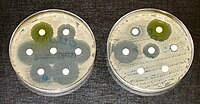
Photo from wikipedia
Wastewater treatment systems are considered as hotspots for release of antibiotic resistance genes (ARGs) into the environment. Anaerobic-aerobic sequential (AAS) bioreactors now are intensively used for wastewater treatment worldwide. However,… Click to show full abstract
Wastewater treatment systems are considered as hotspots for release of antibiotic resistance genes (ARGs) into the environment. Anaerobic-aerobic sequential (AAS) bioreactors now are intensively used for wastewater treatment worldwide. However, the occurrence of ARGs in wastewater treatment systems exposed to low-level (i.e., sub-inhibitory) antibiotic is poorly known. Here, we studied the distribution patterns of seven tetracycline resistance genes (tet genes) including tet(A), tet(C), tet(G), tet(X), tet(M), tet(O), and tet(W), as well as one mobile element [class 1 integron (intI1)] in AAS bioreactors under exposure to tetracycline from 50 μg/L to 500 μg/L. Additionally, effect on the removal performance of nutrients and tetracycline in both anaerobic and aerobic units was also investigated. A tetracycline concentration gradient selected for bacterial resistance in the anaerobic reactor, with the exception of tet(A) and tet(W), and the tetracycline removal deteriorated by 47%. However, the abundance of tet and intI1 genes reduced in the subsequent aerobic unit, and the removal of tetracycline, soluble COD, and NH4+-N maintained at average efficiencies of 91%, 90%, and 93%, respectively. The level of tet(X) was largely unaffected by AAS treatment. It is notable that intI1 genes probably played a crucial role on the horizontal dissemination of tet genes. The tetracycline levels and intI1 genes appear to be the primary factors influencing the occurrence of tet genes in AAS bioreactors. Nonetheless, AAS treatments still show promise for reducing antibiotics, ARGs and mobile elements without affecting nutrient removal, and need further research for practical applications.
Journal Title: Chemosphere
Year Published: 2018
Link to full text (if available)
Share on Social Media: Sign Up to like & get
recommendations!